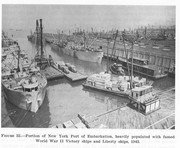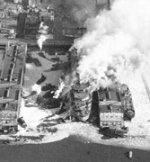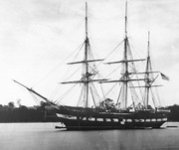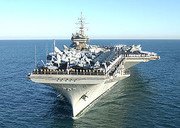From WW II WNYFs - Marine Division facts:
1. Following Pearl Harbor, NYC fireboats patrolled the harbor area 24/7. They only returned to their berths to change crews and fuel.
2. Per US Navy guidance, fireboats were painted over in Navy gray.
3. Fireboats assisted in U Boat harbor security screens.
4. Vessel codes were used to dispatch fireboats to incidents related to large troop and cargo ship incidents - reports were completed by phone after jobs - radio silence was enforced for security.
5. Most of the logistical support for the war came from NYC harbor areas - for security, the busy harbor operated in black-out restrictions at night
6. Half our troops and 1/3 of all war supplies departed through NYC harbor - ammunition ships, fuel supply ships were constant major incident threat - numerous ship fires took place and were down-played for security reasons.
7. The SS El Estro fire, for example, a "potential atom bomb, was defused by FDNY fireboat crews and the US Navy - all crewmembers were decorated
8. A Manhattan Beach summer resort area was taken over by the Coast Guard, during WW II part of the US Navy, and 180,000 were stationed there by 1942 with 24 fireboats to assist FDNY
9. Ship convoys leaving for Europe were "spread-loaded" due to submarine attacks - the result was that all cargo ships could be loaded with explosives, ammunition and other hazardous materials without markings
10. Ferquently, ships in the vicinity of NYC with on-board fires would head for NY harbor for FDNY and Coast Guard help
11. NYC military facilities to protect included:
- NY Port of Embarkation (NYPE) facilities and piers, which moved over 3,000,000 troops and 63,000,000 tons of supplies. NYPE had its own fire units.
- Brooklyn Army Base, 1st Ave and 58th St Bklyn - "largest warehouse in the world" - 48 acres of logistical supplies
- Brooklyn Navy Yard
- Bush Terminal - 29th St to 46th St Bklyn - 100s of ships, 1000s of railroad cars and trucks were unloaded weekly
- Staten Island Terminal, Stapleton - 400,000 sq ft of storage space and tracks for 250 railroad cars
- Floyd Bennett Field, Jamaica Bay - 750 weekly flights of military personnel and cargo
- North River terminal, 12th Ave and 46th St - 7 large piers for embarcation (troop departure) and debarcation (troop return)
- Craven Point NJ - ammunitions and explosive storage
- Howland Hook terminal, Staten Island - petroleum storage to support war
- Fort Hamilton, Fort Wadsworth, Fort Totten, Governor's Island, Miller Field and other NYC military bases located along NYC waterfront
12. Many serious incidents, collisions, barge fires and ship fires ocurred with little publicity due to war security
13. FDNY fireboats were called outside NYC harbor area to assist with fires, explosions and emergencies - a submarine net was in place across the entrance to the harbor - fireboats had to pass through security check points to enter and leave
14. FDNY crews were shorthanded during WW II with large number of members serving in military

1942 Normandie fire:

1. Following Pearl Harbor, NYC fireboats patrolled the harbor area 24/7. They only returned to their berths to change crews and fuel.
2. Per US Navy guidance, fireboats were painted over in Navy gray.
3. Fireboats assisted in U Boat harbor security screens.
4. Vessel codes were used to dispatch fireboats to incidents related to large troop and cargo ship incidents - reports were completed by phone after jobs - radio silence was enforced for security.
5. Most of the logistical support for the war came from NYC harbor areas - for security, the busy harbor operated in black-out restrictions at night
6. Half our troops and 1/3 of all war supplies departed through NYC harbor - ammunition ships, fuel supply ships were constant major incident threat - numerous ship fires took place and were down-played for security reasons.
7. The SS El Estro fire, for example, a "potential atom bomb, was defused by FDNY fireboat crews and the US Navy - all crewmembers were decorated
8. A Manhattan Beach summer resort area was taken over by the Coast Guard, during WW II part of the US Navy, and 180,000 were stationed there by 1942 with 24 fireboats to assist FDNY
9. Ship convoys leaving for Europe were "spread-loaded" due to submarine attacks - the result was that all cargo ships could be loaded with explosives, ammunition and other hazardous materials without markings
10. Ferquently, ships in the vicinity of NYC with on-board fires would head for NY harbor for FDNY and Coast Guard help
11. NYC military facilities to protect included:
- NY Port of Embarkation (NYPE) facilities and piers, which moved over 3,000,000 troops and 63,000,000 tons of supplies. NYPE had its own fire units.
- Brooklyn Army Base, 1st Ave and 58th St Bklyn - "largest warehouse in the world" - 48 acres of logistical supplies
- Brooklyn Navy Yard
- Bush Terminal - 29th St to 46th St Bklyn - 100s of ships, 1000s of railroad cars and trucks were unloaded weekly
- Staten Island Terminal, Stapleton - 400,000 sq ft of storage space and tracks for 250 railroad cars
- Floyd Bennett Field, Jamaica Bay - 750 weekly flights of military personnel and cargo
- North River terminal, 12th Ave and 46th St - 7 large piers for embarcation (troop departure) and debarcation (troop return)
- Craven Point NJ - ammunitions and explosive storage
- Howland Hook terminal, Staten Island - petroleum storage to support war
- Fort Hamilton, Fort Wadsworth, Fort Totten, Governor's Island, Miller Field and other NYC military bases located along NYC waterfront
12. Many serious incidents, collisions, barge fires and ship fires ocurred with little publicity due to war security
13. FDNY fireboats were called outside NYC harbor area to assist with fires, explosions and emergencies - a submarine net was in place across the entrance to the harbor - fireboats had to pass through security check points to enter and leave
14. FDNY crews were shorthanded during WW II with large number of members serving in military

1942 Normandie fire:



